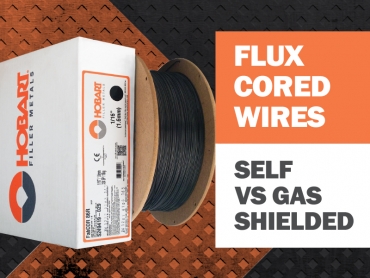From our valued friends at WIA. Original article can be found here

All about Flux Cored Wires
Today productivity is important, and that’s why flux cored wires is a filler metal that should be considered. With higher deposition rates and operator efficiencies, they offer productivity benefits, high performance and great weld quality. Suitable for a range of industries, flux cored wires are a great solution for general fabrication, manufacturing, construction, offshore and shipbuilding applications.
If you’re deciding to make the switch to flux cored wires it’s important to take all things into consideration, such as the mechanical and chemical properties of the base metal, the required welding position, the equipment, the work environment and the welder’s skill set, because these all play a factor when making the choice.
Additionally, welding characteristics of the filler metal, advantages and requirements all need to be considered when deciding if using flux cored wires is the right choice.
Self-Shielded vs Gas Shielded
There are two kinds of flux cored wires, self-shielded and gas shielded, both can weld a variety of base metals including mild steel and low alloy steel. In addition, gas shielded offers stainless steel and nickel alloys.
Self Shielded
The difference with self-shielding wires is that they do not require a shielding gas when the arc is active, which eliminates the need for a gas cylinder. This makes it a great choice for remote applications or when portability is important. Self-shielded wires are also a great choice for outdoor welding and windy conditions because the wire can withstand strong windy conditions.
These wires offer good impact toughness even at lower temperatures, however when comparing them to gas-shielded wires, they can produce higher levels of smoke and spatter.
Self-shielded wires are a good substitute for shielded metal arc welding electrodes, due to their ability to increase productivity. Unlike electrodes flux cored wires don’t need to be changed over and over again which as a result reduces downtime for changeover.
Gas Shielded
On the other hand, gas shielded wires have higher operator appeal, meaning they are easier to control and use and produce higher quality welds. These wires are a good substitute to solid wires because of their ability to produce higher deposition rates, which can get the job done a lot faster.
Gas shielded wires are suitable for thicker metals or in out-of-position applications and have a molten slag that solidifies more quickly than the weld pool. As a result, it creates a “shelf” to hold the molten pool when welding overhead or vertically up.
Unlike self shielded wires, gas shielded wires aren’t as suitable for outdoor conditions. Any wind or movement in the air can affect the shielding gas performance and weld quality and will result in porosity to become visible in the weld bead.
Conclusion
Both self and gas shielded wires are different, and should be chosen based on the application type, however both produce high quality welds, repeatable performance and consistency, and can be great alternatives to other filler metals.
If you’ve considered the switch to flux cored wires, there is no better time. Hobart has a great range of flux cored wires for a wide range of applications.
WIA can help you choose the right flux cored wire for the job!
Give one of our Filler Metal Specialists a call, and organise a trial and or product demonstration. They can help you choose the right Hobart wire for your job.
Find out about Hobart Flux Cored wires here.
Call an Aitken Welding Supplies branch today to help you make the right decision at the right price!

